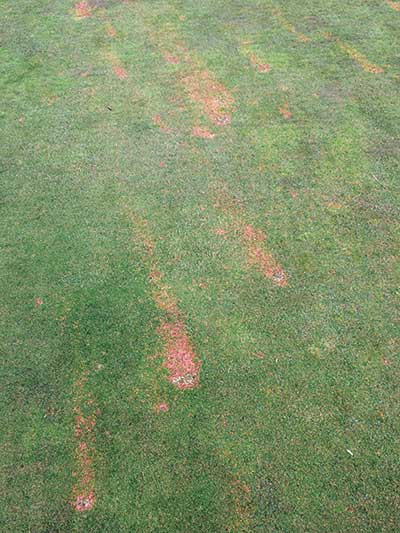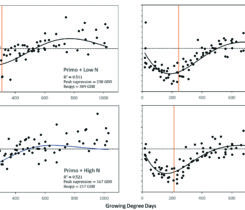Now is the time for snow mold control
Snow mold is a blanket term for several different pathogens that favor prolonged cool and wet conditions. While gray and speckled snow mold are more prevalent in areas with extended snow coverage, pink snow mold occurs as far south as Mississippi and Texas.

Streaks of pink snow mold show traffic as the likely source of its spread on this golf course in British Columbia. (Photo courtesy of Paul Koch)
“For a good portion of the winter, the disease can occur really anywhere in the country that can have wet conditions during the winter that persist in the 40s and 50s,” says Paul Koch, Ph.D., assistant professor in the department of plant pathology at the University of Wisconsin-Madison.
Koch says in southern parts of the country, snow mold won’t be long-lasting or damaging. A few years ago, Tennessee suffered a large snow event and superintendents in the state saw pink snow mold on their courses. While these occurrences are infrequent, Koch says, “Just because you might be in the South, it’s not a disease that you can completely ignore.”
Superintendents should limit contact of infected areas when the pathogen is fully active as it is spread by rain and by golf course traffic. Signs of fluffy mycelium patches in the areas with snow mold mean spores are active.
“If you drive your mower through it, if you’re allowing golf cart or golf walker traffic to go through that, they can easily spread it,” Koch says. “We’ve seen pictures where you can see the streaking of the disease from the mower.”
Cultural controls such as mowing or rolling to get moisture off the turf will help limit the pathogen’s spread. Koch also suggests limiting nitrogen applications when the turf is most susceptible, as nitrogen will only fuel the snow mold pathogen in those ideal conditions. Koch says superintendents should also look to increase airflow, whether that’s through tree pruning or tree removal, to help the turf dry out faster.
Koch recommends strobilurin and DMI fungicides for preventive snow mold applications as well as for some curative control. Fludioxonil is another option for pink snow mold control.

Chuck Silcox, Ph.D. (Photo: Amguard Environmental Technologies)
Amguard Environmental Technologies
Chuck Silcox, Ph.D.
Product development manager
Anticipate you’re going to have snow mold because you can’t go back midwinter and treat. Remember the disease triangle: You have the pathogen, you have a host and you have the environment. You have to get all three factors to interact for the disease to develop. Ideally, you’d put an application on in late fall and forget about it. In spring, if you have some areas with snow mold and it looks like you’re going to have a period of relatively cool, damp weather, then it’s probably worth making a fungicide application, which can cover the early spring diseases as well. Culturally, you want to rake and/or mow and lightly fertilize to get the turf growing and get recovery.

Brian Aynardi (Photo: PBI Gordon)
PBI-Gordon Corp.
Brian Aynardi, Ph.D.
Northeast research scientist
Pink snow mold is most prevalent in cooler climates, particularly the Northeast, Upper Midwest and Pacific Northwest (also referred to as Microdochium patch), but it can occur throughout most of the country including on bermudagrass putting greens. Gray snow mold is found in areas of prolonged snow cover greater than 40 days. The best prevention for gray and pink snow mold is fungicides applied in the fall prior to snow cover. For pink snow mold, additional applications may be made when snow cover does not exist, particularly in the spring as the pathogen is active at temperatures well above freezing. Resistance is not a concern with gray snow mold, but there is a high risk for resistance to develop with the pink snow mold pathogen, Microdochium nivale, including documented resistance to the dicarboxamides.

Matt Giese (Photo: Syngenta)
Syngenta
Matt Giese
Technical Services Manager
Snow mold management requires a little bit of past knowledge about what happens on your course and what’s effective. If you have a couple of low-pressure years and get lulled into a sense of complacency where two active ingredients combined are effective, and then you get a heavy-pressure year, those two active ingredients may not be able to sustain that level of control. You need to take more of a preventive approach — especially if your threshold for damage is low. I look at snow mold protection the same as car insurance. You don’t wait until you have an accident to buy insurance. Similarly, you have to put that insurance in place before snow mold occurs with preventive fall applications. If there is consistent damage every year, it certainly makes a lot of sense to try and manage it preventively rather than waiting until after you actually have it.
Prime Source

Bret Corbett (Photo: Prime Source)
Bret Corbett
Director of technical services
Aerifying and verticutting and anything you can do to remove as much thatch as possible will help combat snow mold. Make sure you continue to mow until growing ceases. For preventative sprays, typically, you need a combination of fungicides to be effective. These would include combining a contact fungicide, with QoIs, DMIs, and SDHIs. Managing healthy turf is the best way to prevent any disease or decrease the severity of a disease. Follow best management practices, develop an IPM program, get ahead with proper scouting, make sure you put preventive fungicides out before the snow cover and decrease the amount of nitrogen per year. That’s your best way to eliminate the disease pressure.












